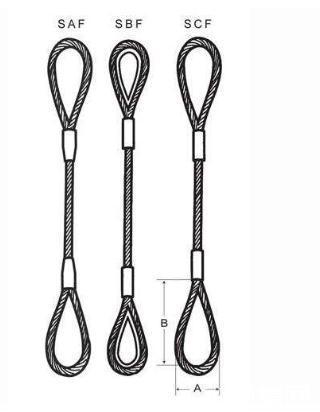Hello, welcome to visit Jiangsu Changjiang Steel Rope Co., LTD. The official website!
National hotline:+86 13862904398
Design of Steel Wire Rope Loading Cable: Tension Calculation, Selection and Installation
- Categories:Industry news
- Author:
- Origin:
- Time of issue:2020-03-26 10:28
- Views:
(Summary description)According to GB 50127-2007 Technical Specification for Overhead Cableway Engineering and GB 12141-2008 Safety Specification for Freight Overhead Cableway, in the design of cableway, the steel wire rope must be chosen for the load-carrying rope. As a whole, the cable is a flexible member and only bears tension. Its material obeys Hooke's law. At the same time, the deformation of the hinges of the supporting cables is neglected in the analysis of the forces acting on the supporting cables. Thus, the forces acting on the supporting cables can be analyzed and calculated according to the parabolic theory, and the tension, sag, tangent inclination, curvature radius and curve length of the supporting cables can be solved. Installation Length of Bearing Cables... The maximum sag of overload is usually proposed by the user in the task book.
Design of Steel Wire Rope Loading Cable: Tension Calculation, Selection and Installation
(Summary description)According to GB 50127-2007 Technical Specification for Overhead Cableway Engineering and GB 12141-2008 Safety Specification for Freight Overhead Cableway, in the design of cableway, the steel wire rope must be chosen for the load-carrying rope. As a whole, the cable is a flexible member and only bears tension. Its material obeys Hooke's law. At the same time, the deformation of the hinges of the supporting cables is neglected in the analysis of the forces acting on the supporting cables. Thus, the forces acting on the supporting cables can be analyzed and calculated according to the parabolic theory, and the tension, sag, tangent inclination, curvature radius and curve length of the supporting cables can be solved. Installation Length of Bearing Cables... The maximum sag of overload is usually proposed by the user in the task book.
- Categories:Industry news
- Author:
- Origin:
- Time of issue:2020-03-26 10:28
- Views:
According to GB 50127-2007 Technical Specification for Overhead Cableway Engineering and GB 12141-2008 Safety Specification for Freight Overhead Cableway, in the design of cableway, the steel wire rope must be chosen for the load-carrying rope. As a whole, the cable is a flexible member and only bears tension. Its material obeys Hooke's law. At the same time, the deformation of the hinges of the supporting cables is neglected in the analysis of the forces acting on the supporting cables. Thus, the forces acting on the supporting cables can be analyzed and calculated according to the parabolic theory, and the tension, sag, tangent inclination, curvature radius and curve length of the supporting cables can be solved. Installation Length of Bearing Cables... The maximum sag of overload is usually proposed by the user in the task book.

In the design and calculation of load-carrying cables, it is generally necessary to consider not only the high output, low cost, but also the safety and reliability of production, which requires multi-scheme design and calculation. Especially, the calculation formula of multi-span overhead cableway is complicated, and the calculation workload is large, which makes the designer feel very difficult. Next, a single-span reciprocating load-carrying cable design example is given to illustrate the fast-loading ropeway load-carrying cable and its application.
User's Task Sheet: The length of load-carrying cable is 220 meters (maximum horizontal distance is 150 meters, maximum height is 150 meters), maximum cargo load is 1 ton, line gradient is 0-45 degrees, which requires the fastest installation of design load-carrying cable.
In this example, when the sag is given, the supporting force of the load cable to the truck is mainly affected by two factors: one is the change with the taxiing process of the truck; the other is the change with the installation height difference between the upper and lower fulcrums. The theoretical analysis shows that the maximum deflection and the maximum tension of the load cable occur when the truck taxiing to the mid-span. By calculating the tension of the two fulcrums under the conditions of horizontal installation and 45 degree gradient installation, it is concluded that the tension of the load-carrying cable is the greatest when the load-carrying cable is installed at 45 degree gradient. The calculation process of the maximum tension produced by the load-carrying cable during the installation of a 45 degree gradient is given below, as shown in Fig. 1 below.
1 Deflection Selection
The working sag of overhead cableway load-carrying cables (the ratio of maximum deflection to horizontal span) is generally 0.05-0.07, and the optimum sag is 0.055-0.06. (In New Year's "Design of overhead cableway", 0.04-0.06 is given.) If we choose the minimum sag of 0.055, we can calculate the maximum deflection f in the span.
F = epsilon xL = 150 x0.055 = 8.25 meters.
However, considering the particularity of this ropeway, that is to say, in order to ensure the geological condition of 0-45 degrees along the line, all the obstacles can be passed, and considering the erection height of the supports comprehensively, the minimum deflection is 4 meters in actual calculation.
That is, when two fulcrums are installed horizontally, according to the height of the ropeway bracket 8.4 meters and the length of the hook 0.4 meters, assuming that the extension of the bundle cable is 1 meter, if the distance between the reserved obstacle point and the bottom end of the suspended object is 0.5 meters, when the slope of the topographic slope is parallel to the ropeway basement, the maximum height of the suspended object H:
H = 8.4-0.4-1.0-0.5-4.0 = 2.9m
The height of the suspended object shall not be greater than 2.9 meters.
2. Tension calculation of load-bearing cables
According to the principle of force balance, when the load is concentrated at the midpoint, in order to simplify the calculation, the load-carrying cable is regarded as a flexible component, ignoring the load-sharing effect of the load-carrying cable.
Horizontal component of gravity; (T+t) sina-T sin beta = 0
Vertical component of gravity; (T+t) cos alpha-Tcos beta-1 = 0
Among them, T is the tension of the load-bearing cable, t is the angle between the upper part of the load-point traction cable and the vertical line, and beta is the angle between the lower part of the load-point traction cable and the vertical line, and 1 is the required supporting force.
Design of Steel Wire Rope Loading Cable: Tension Calculation, Selection and Installation
According to the calculation of galloping degree, when h = 4, the calculated results are as follows: T = 12.89 tons, t = 0.71 tons.
In this example, when the traction cable stays at the midpoint, the traction cable will be completely released, and the suspended object will stay by the friction force between the pulley and the load cable. The maximum tension of the upper half of the actual load cable will contain the load component, i.e. the load-carrying cable tension and the traction force of the traction cable, which is T+t=12.89+0.71=13.6 tons.
Selection and Installation of 3 Bearing Cables
According to GB12141-2008 Code for Safety of Overhead Cableway for Freight Transportation, steel rope should be selected to meet the requirements of GB8918 or YB/T5295. In order to reduce the weight of steel wire rope, the important purpose steel wire rope is selected. The tensile strength level is 1870 Mp, and the safety factor of the load-carrying cable is 3.0 by checking the table.
Calculating the Minimum Breaking Tensile Force of Wire Rope T0:T0=3.0X13.6=40.8 Ton Force
The filling steel wire rope of strength grade 1870 is selected, and the minimum diameter of the steel wire rope is 24mm.
The weight ratio of 24 mm diameter wire rope is about 230 Kg/100 M. The weight of 220 m (regardless of end manufacture) wire rope is calculated. The result is: G = 230 Kg/100X220 = 506 Kg.
When loading cable is installed, one end of loading cable is fixed and the other end is tensioned. The fixed end is made into a ring eye, because the loading rope may only need to use a part of the loading rope when releasing the rope. According to the usual method, in order to reduce the amount of labor, only the wire rope ring eye end is chosen to lay the rope directly. When laying the rope, the quality of the wire rope is heavier, and it is not allowed to rub on the ground and contaminate the earth and rocks. Generally, pulling rope is used to lay the rope, which is pulled by the steering pulley to release the rope with tension (in this design, considering the weight of the tractor and the difficulty of handling, the tractor is usually only installed in the place where the truck can easily unload the goods).
In order to save time, the tension of the load-carrying rope does not adopt the form of counterweight. The tension method mentioned by Zhou Zhigang in "Design of Anchorage Device at Two Ends of Double-load Cables for Reciprocating Passenger Cableway" is borrowed. In this method, in order to shorten the stroke of hydraulic cylinder as short as possible, the hydraulic cylinder is tightened gradually through hand-pulled hoist to achieve an estimated tension force. At the tightening end, multiple rope clamps are used to fix the load cable. The load cable is connected with the anchoring frame through two groups of rope clamps and two long screw and tightening frame. Then, through a hydraulic system, the hydraulic cylinder is tightened and the load cable is tightened. At the clamping end of the load cable, a pressure sensor is connected to measure and display the real-time tension force of the load cable.
Scan the QR code to read on your phone
E-mail:sales@asiajscj.com jackguo@asiajscj.com
Add:No.39,Ruixing Road,Nantong City,Jiangsu Province,China
WhatsApp:0086-13862904398
Facebook: 0086-13862904398
Wechat: 0086-13862904398

- Mobile -
Copyright © 2020 Jiangsu Changjiang Steel Rope Co. Ltd. all rights reserved.







